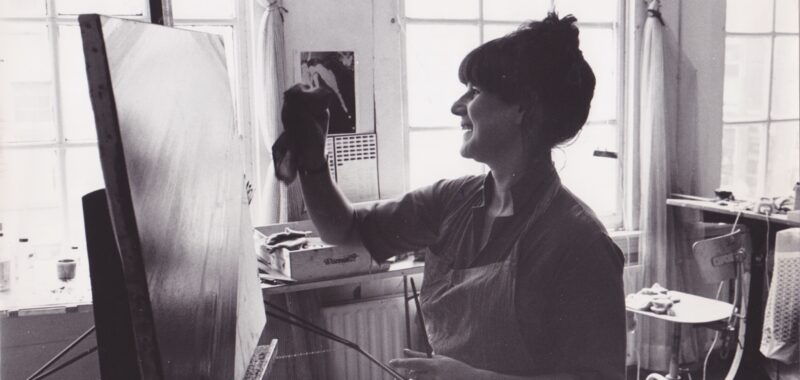Dutch painter Jacqueline de Jong, celebrated for her contributions to painterly figuration and for her role in Europe’s avant-garde Situationist movement, died on Saturday, June 29 in Amsterdam at the age of 85. The cause was metastatic liver cancer, as confirmed by Ortuzar Projects, the gallery representing the artist in New York City.
De Jong was born in 1939 to a Jewish art-aligned family in the Dutch town of Hengelo months before the onset of World War II. Fearing the consequences of the German invasion in the Netherlands, the de Jongs went into hiding, and Jacqueline and her mother soon fled to Zurich, where they were temporarily separated due to lack of accommodations. Upon her return to her native country in 1946 after the war, de Jong struggled to adjust as she re-learned the Dutch language. Her interest in art, particularly performance, emerged as a displaced young girl and was cemented in her teenage years.

At the age of 18, de Jong moved to Paris and worked for Christian Dior’s boutique while studying French and theater. She relocated to London in 1958 to enroll in the Guildhall School of Music and Drama but returned to the Netherlands shortly thereafter, working part-time at the Stedelijk Museum while pursuing painting on her own time as a self-taught artist.
While employed at the museum, the artist became involved in and soon assumed a high-level role in the Dutch faction of the Situationist International, an anti-capitalist, avant-garde movement made up of artists, writers, and political theorists that was prominent in Europe from 1957 until its dissolution in 1972. A conflict with the group’s leader, Guy Debord, led to de Jong’s formal exit from the movement, which in turn enabled her to create her own topical publication called the Situationist Times. De Jong edited, designed, and published six editions of the magazine between 1962 and 1967 with various contributors, and also distributed revolutionary literature and printed posters in Paris during the May 1968 protests.
Throughout her journey with the Situationists, de Jong also maintained a commitment to her artistic practice and incorporated it into her activism. Amid the global sweep of abstraction throughout the 1960s, she grew more interested in making figurative work, engaging in a gawky, naive, part-Expressionist and part-cartoonish style that stripped away any notions of pleasantries and politeness to expose the raw wounds, absurdities, and eroticism of the human condition. In addition to her parents’ collection of modern art, she was deeply inspired by the likes of Max Beckmann, Rembrandt, Hercules Seghers, Nicolas de Staël, and the Dada movement.

Provocative, candid, political, and unmistakably feminist, de Jong’s radical art practice primarily gleaned appreciation in the Netherlands, with special attention afforded to her Accidental Paintings and Suicidal Painting series. However, in recent years, admiration for the artist has expanded throughout Europe and North America. In 2018, Les Abattoirs in the French city of Toulouse hosted a major survey of her historic work from the 1960s, including her May ’68 posters, juxtaposed with her recent pieces and related ephemera.
A selection of de Jong’s latest works responding to the violence seen in Ukraine and Gaza today, and as it roots to her childhood displacement as well as her early-adulthood activism are on view in her solo exhibition, La Petite Mort at Pippy Houldsworth Gallery in London until July 13. Ortuzar Projects also confirms that de Jong’s first survey in the United States is slated for this year at the Nova Southeastern University Art Museum in Fort Lauderdale, Florida.

